PEUGEOT 308 CC 2013 Owners Manual
Manufacturer: PEUGEOT, Model Year: 2013, Model line: 308 CC, Model: PEUGEOT 308 CC 2013Pages: 268, PDF Size: 15.28 MB
Page 91 of 268
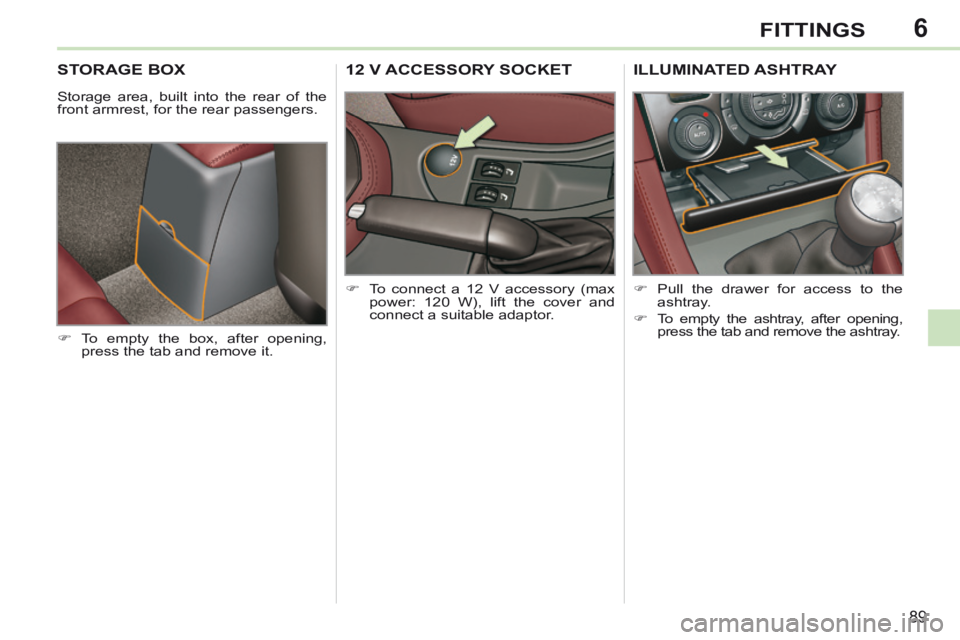
6
89
FITTINGS
STORAGE BOX
Storage area, built into the rear of the
front armrest, for the rear passengers.
To empty the box, after opening, press the tab and remove it.
12 V ACCESSORY SOCKET
To connect a 12 V accessory (max power: 120 W), lift the cover and
connect a suitable adaptor.
ILLUMINATED ASHTRAY
Pull the drawer for access to the ashtray.
To empty the ashtray, after opening, press the tab and remove the ashtray.
Page 92 of 268
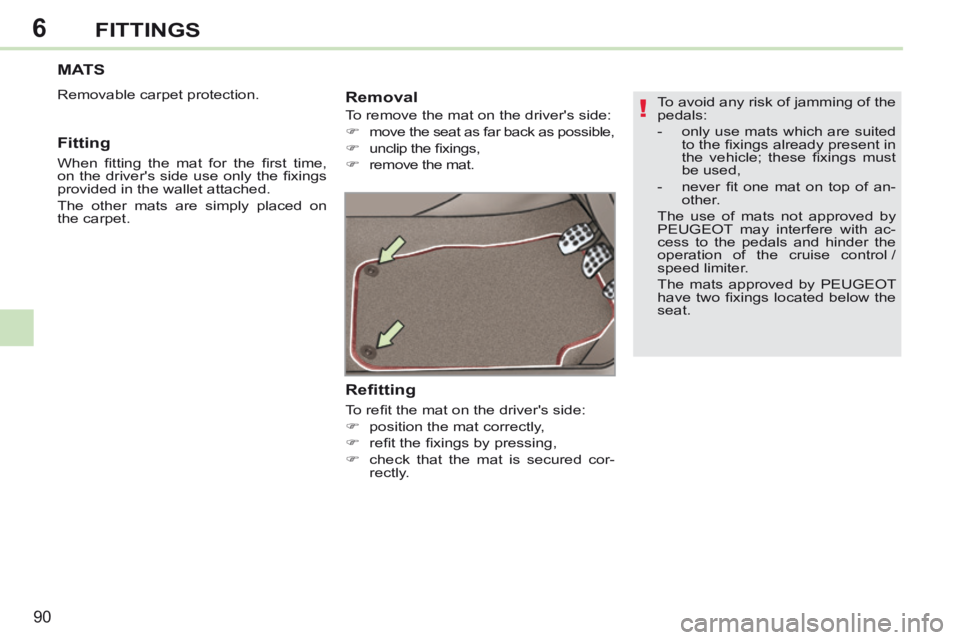
6
!
90
FITTINGS
To avoid any risk of jamming of the
pedals:
- only use mats which are suited to the fi xings already present in
the vehicle; these fi xings must
be used,
- never fi t one mat on top of an- other.
The use of mats not approved by
PEUGEOT may interfere with ac-
cess to the pedals and hinder the
operation of the cruise control /
speed limiter.
The mats approved by PEUGEOT
have two fi xings located below the
seat.
MATS
Removable carpet protection.
Refitting
To refi t the mat on the driver's side:
position the mat correctly,
refi t the fi xings by pressing,
check that the mat is secured cor- rectly.
Fitting
When fi tting the mat for the fi rst time,
on the driver's side use only the fi xings
provided in the wallet attached.
The other mats are simply placed on
the carpet.
Removal
To remove the mat on the driver's side:
move the seat as far back as possible,
unclip the fi xings,
remove the mat.
Page 93 of 268
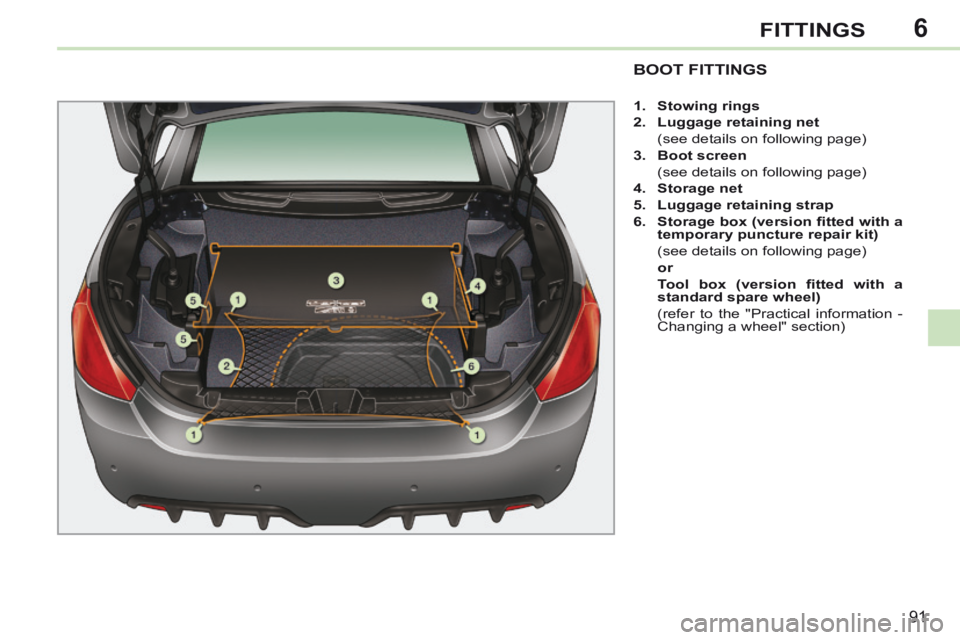
6
91
FITTINGS
BOOT FITTINGS
1. Stowing rings
2. Luggage retaining net
(see details on following page)
3. Boot screen
(see details on following page)
4. Storage net
5. Luggage retaining strap
6. Storage box (version fi tted with a temporary puncture repair kit)
(see details on following page)
or
Tool box (version fi tted with a
standard spare wheel)
(refer to the "Practical information - Changing a wheel" section)
Page 94 of 268

6
i
92
FITTINGS
Hooked onto the stowing rings, this en-
ables you to secure your luggage.
Luggage retaining net
Raise the boot carpet to gain access to the storage box.
Hook the boot carpet on the boot seal using its handle.
This has areas for storing the windstop
and two warning triangles.
By removing this box you gain access
to the temporary tyre repair kit and the
vehicle tools.
Storage box Boot screen
In the "cabriolet" confi guration, this de-
fi nes the luggage space in the boot.
When the boot screen is unfolded,
check that the luggage:
- never raises it,
- is never placed on top of it.
The load space cover must always
be unfolded before a roof opening
manoeuvre is triggered (refer to
"Familiarisation - Opening" section).
Page 95 of 268
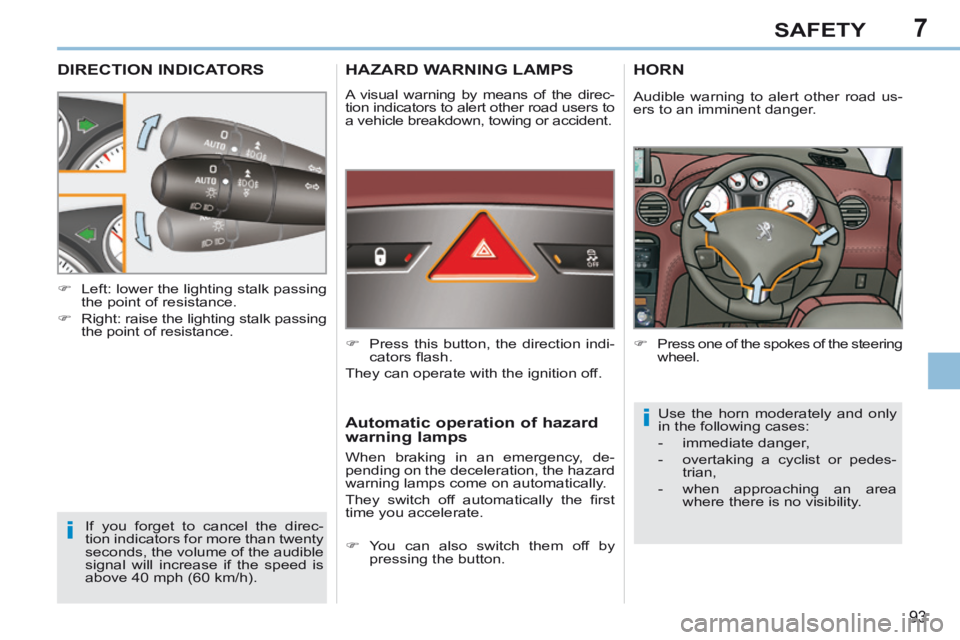
7
i
i
93
SAFETY
DIRECTION INDICATORS
If you forget to cancel the direc-
tion indicators for more than twenty
seconds, the volume of the audible
signal will increase if the speed is
above 40 mph (60 km/h).
Left: lower the lighting stalk passing
the point of resistance.
Right: raise the lighting stalk passing the point of resistance.
HAZARD WARNING LAMPS
A visual warning by means of the direc-
tion indicators to alert other road users to
a vehicle breakdown, towing or accident.
Press this button, the direction indi-cators fl ash.
They can operate with the ignition off.
Automatic operation of hazard
warning lamps
When braking in an emergency, de-
pending on the deceleration, the hazard
warning lamps come on automatically.
They switch off automatically the fi rst
time you accelerate.
You can also switch them off by pressing the button.
HORN
Press one of the spokes of the steering wheel.
Use the horn moderately and only
in the following cases:
- immediate danger,
- overtaking a cyclist or pedes- trian,
- when approaching an area where there is no visibility.
Audible warning to alert other road us-
ers to an imminent danger.
Page 96 of 268
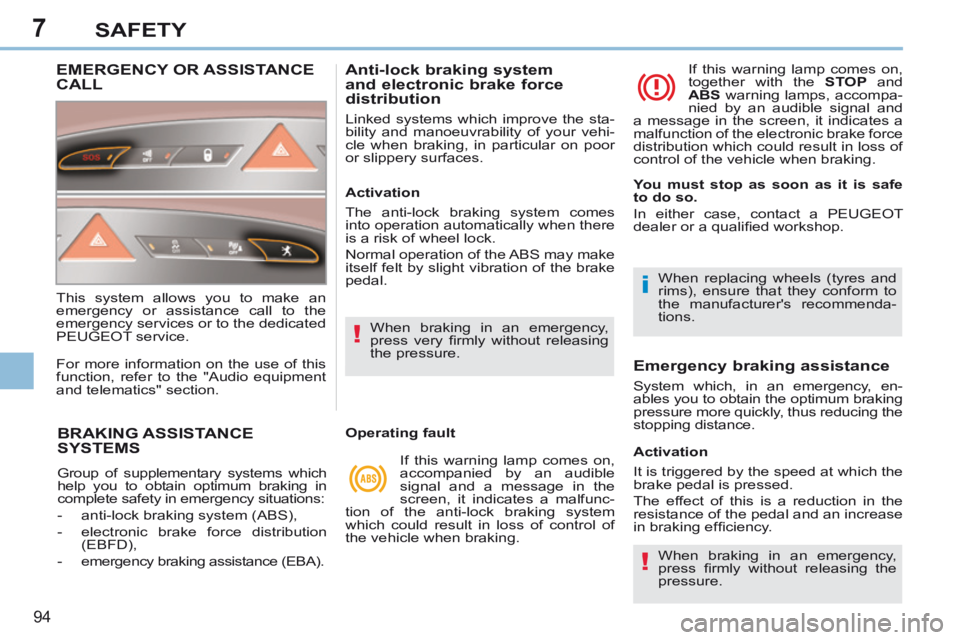
7
!
i
!
94
SAFETY
BRAKING ASSISTANCE SYSTEMS
Group of supplementary systems which
help you to obtain optimum braking in
complete safety in emergency situations:
- anti-lock braking system (ABS),
- electronic brake force distribution (EBFD),
- emergency braking assistance (EBA).
Anti-lock braking system
and electronic brake force
distribution
Linked systems which improve the sta-
bility and manoeuvrability of your vehi-
cle when braking, in particular on poor
or slippery surfaces.
When braking in an emergency,
press very fi rmly without releasing
the pressure. When replacing wheels (tyres and
rims), ensure that they conform to
the manufacturer's recommenda-
tions.
Operating fault If this warning lamp comes on,
accompanied by an audible
signal and a message in the
screen, it indicates a malfunc-
tion of the anti-lock braking system
which could result in loss of control of
the vehicle when braking. If this warning lamp comes on,
together with the
STOP and
ABS warning lamps, accompa-
nied by an audible signal and
a message in the screen, it indicates a
malfunction of the electronic brake force
distribution which could result in loss of
control of the vehicle when braking.
Emergency braking assistance
System which, in an emergency, en-
ables you to obtain the optimum braking
pressure more quickly, thus reducing the
stopping distance.
Activation
The anti-lock braking system comes
into operation automatically when there
is a risk of wheel lock.
Normal operation of the ABS may make
itself felt by slight vibration of the brake
pedal.
Activation
It is triggered by the speed at which the
brake pedal is pressed.
The effect of this is a reduction in the
resistance of the pedal and an increase
in braking effi ciency. When braking in an emergency,
press fi rmly without releasing the
pressure.
You must stop as soon as it is safe
to do so.
In either case, contact a PEUGEOT
dealer or a qualifi ed workshop.
EMERGENCY OR ASSISTANCE CALL
This system allows you to make an
emergency or assistance call to the
emergency services or to the dedicated
PEUGEOT service.
For more information on the use of this
function, refer to the "Audio equipment
and telematics" section.
Page 97 of 268
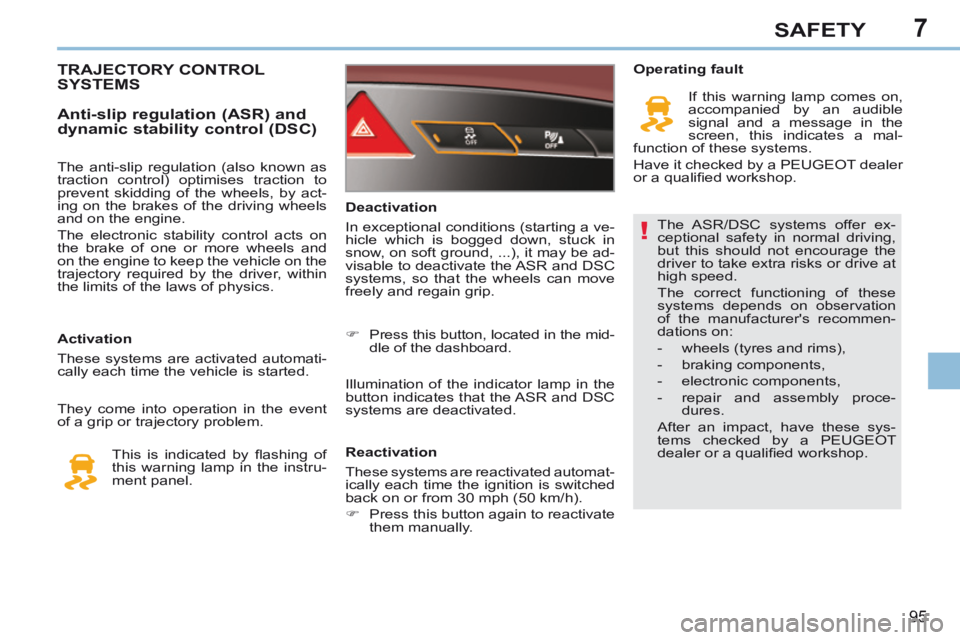
7
!
95
SAFETY
The ASR/DSC systems offer ex-
ceptional safety in normal driving,
but this should not encourage the
driver to take extra risks or drive at
high speed.
The correct functioning of these
systems depends on observation
of the manufacturer's recommen-
dations on:
- wheels (tyres and rims),
- braking components,
- electronic components,
- repair and assembly proce-dures.
After an impact, have these sys-
tems checked by a PEUGEOT
dealer or a qualifi ed workshop.
Deactivation
In exceptional conditions (starting a ve-
hicle which is bogged down, stuck in
snow, on soft ground, ...), it may be ad-
visable to deactivate the ASR and DSC
systems, so that the wheels can move
freely and regain grip.
Press this button, located in the mid- dle of the dashboard.
Illumination of the indicator lamp in the
button indicates that the ASR and DSC
systems are deactivated.
Reactivation
These systems are reactivated automat-
ically each time the ignition is switched
back on or from 30 mph (50 km/h).
Press this button again to reactivate them manually. Operating fault
If this warning lamp comes on,
accompanied by an audible
signal and a message in the
screen, this indicates a mal-
function of these systems.
Have it checked by a PEUGEOT dealer
or a qualifi ed workshop.
TRAJECTORY CONTROL SYSTEMS
Activation
These systems are activated automati-
cally each time the vehicle is started.
Anti-slip regulation (ASR) and
dynamic stability control (DSC)
They come into operation in the event
of a grip or trajectory problem.
This is indicated by fl ashing of
this warning lamp in the instru-
ment panel.
The anti-slip regulation (also known as
traction control) optimises traction to
prevent skidding of the wheels, by act-
ing on the brakes of the driving wheels
and on the engine.
The electronic stability control acts on
the brake of one or more wheels and
on the engine to keep the vehicle on the
trajectory required by the driver, within
the limits of the laws of physics.
Page 98 of 268
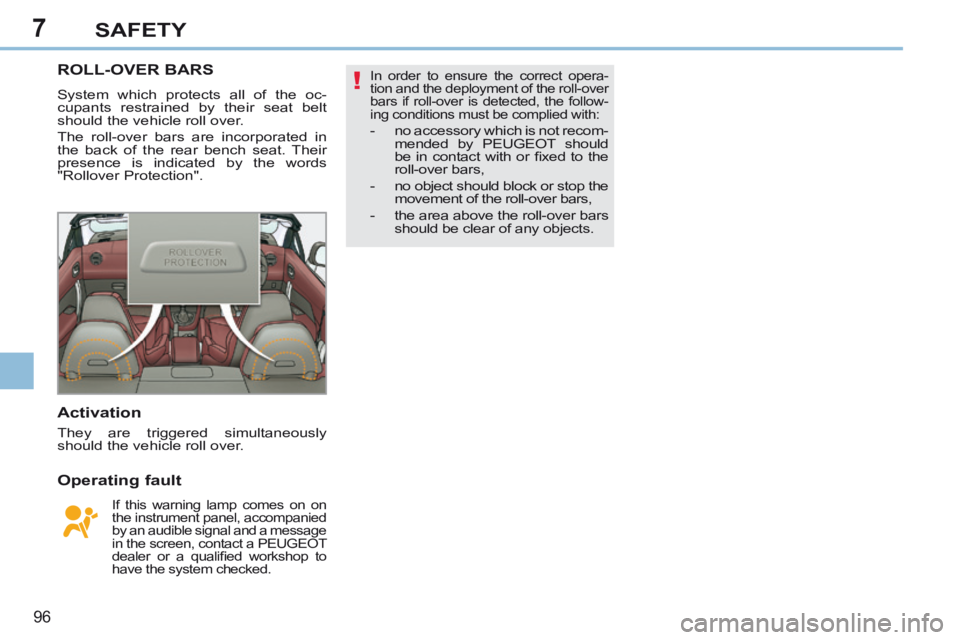
7
!
96
SAFETY
ROLL-OVER BARS
System which protects all of the oc-
cupants restrained by their seat belt
should the vehicle roll over.
The roll-over bars are incorporated in
the back of the rear bench seat. Their
presence is indicated by the words
"Rollover Protection".
Activation
They are triggered simultaneously
should the vehicle roll over.
Operating fault
If this warning lamp comes on on
the instrument panel, accompanied
by an audible signal and a message
in the screen, contact a PEUGEOT
dealer or a qualifi ed workshop to
have the system checked. In order to ensure the correct opera-
tion and the deployment of the roll-over
bars if roll-over is detected, the follow-
ing conditions must be complied with:
- no accessory which is not recom-
mended by PEUGEOT should
be in contact with or fi xed to the
roll-over bars,
- no object should block or stop the movement of the roll-over bars,
- the area above the roll-over bars should be clear of any objects.
Page 99 of 268
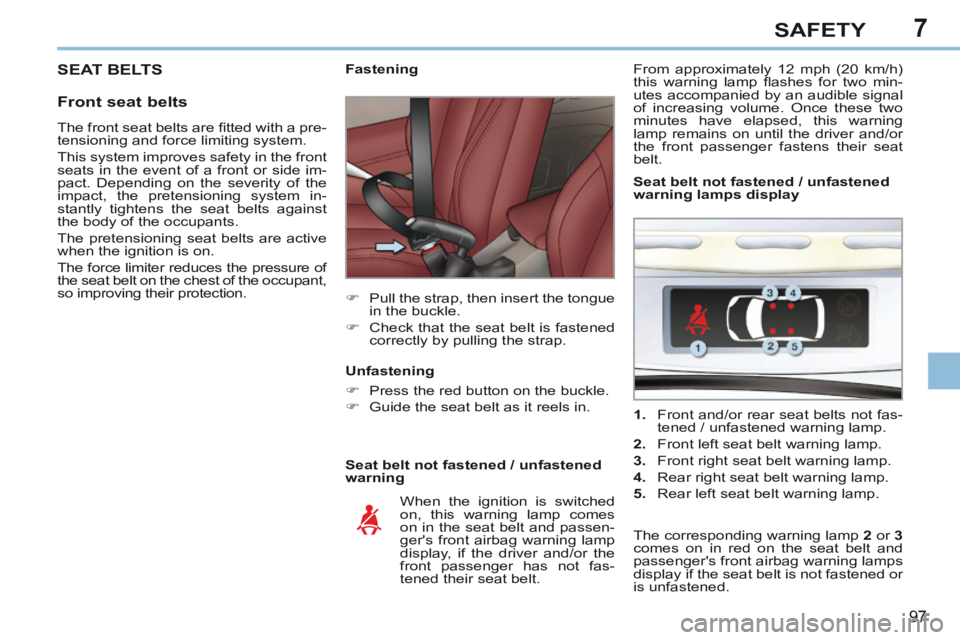
7
97
SAFETY
SEAT BELTS
Front seat belts
Seat belt not fastened / unfastened
warning Fastening
Pull the strap, then insert the tongue in the buckle.
Check that the seat belt is fastened correctly by pulling the strap.
When the ignition is switched
on, this warning lamp comes
on in the seat belt and passen-
ger's front airbag warning lamp
display, if the driver and/or the
front passenger has not fas-
tened their seat belt.
Unfastening
Press the red button on the buckle.
Guide the seat belt as it reels in.
1. Front and/or rear seat belts not fas-
tened / unfastened warning lamp.
2. Front left seat belt warning lamp.
3. Front right seat belt warning lamp.
4. Rear right seat belt warning lamp.
5. Rear left seat belt warning lamp. Seat belt not fastened / unfastened
warning lamps display
The corresponding warning lamp 2 or 3
comes on in red on the seat belt and
passenger's front airbag warning lamps
display if the seat belt is not fastened or
is unfastened.
From approximately 12 mph (20 km/h)
this warning lamp fl ashes for two min-
utes accompanied by an audible signal
of increasing volume. Once these two
minutes have elapsed, this warning
lamp remains on until the driver and/or
the front passenger fastens their seat
belt.
The front seat belts are fi tted with a pre-
tensioning and force limiting system.
This system improves safety in the front
seats in the event of a front or side im-
pact. Depending on the severity of the
impact, the pretensioning system in-
stantly tightens the seat belts against
the body of the occupants.
The pretensioning seat belts are active
when the ignition is on.
The force limiter reduces the pressure of
the seat belt on the chest of the occupant,
so improving their protection.
Page 100 of 268
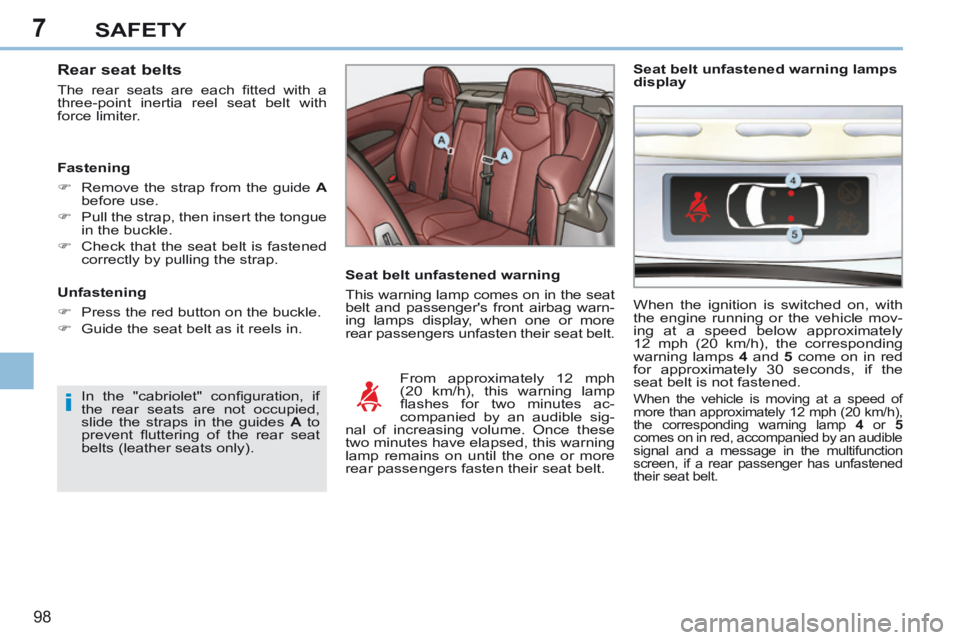
7
i
98
SAFETY
Rear seat belts
The rear seats are each fi tted with a
three-point inertia reel seat belt with
force limiter.
Fastening
Remove the strap from the guide A
before use.
Pull the strap, then insert the tongue in the buckle.
Check that the seat belt is fastened correctly by pulling the strap. Seat belt unfastened warning lamps
display
When the ignition is switched on, with
the engine running or the vehicle mov-
ing at a speed below approximately
12 mph (20 km/h), the corresponding
warning lamps
4 and 5 come on in red
for approximately 30 seconds, if the
seat belt is not fastened.
When the vehicle is moving at a speed of
more than approximately 12 mph (20 km/h),
the corresponding warning lamp 4 or 5
comes on in red, accompanied by an audible
signal and a message in the multifunction
screen, if a rear passenger has unfastened
their seat belt.
Unfastening
Press the red button on the buckle.
Guide the seat belt as it reels in. Seat belt unfastened warning
This warning lamp comes on in the seat
belt and passenger's front airbag warn-
ing lamps display, when one or more
rear passengers unfasten their seat belt.
In the "cabriolet" confi guration, if
the rear seats are not occupied,
slide the straps in the guides A to
prevent fl uttering of the rear seat
belts (leather seats only). From approximately 12 mph
(20 km/h), this warning lamp
fl ashes for two minutes ac-
companied by an audible sig-
nal of increasing volume. Once these
two minutes have elapsed, this warning
lamp remains on until the one or more
rear passengers fasten their seat belt.